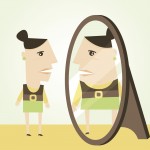
It’s hardly surprising that teenage girls and boys express dissatisfaction with their bodies. The vast majority of TV, magazine, billboard and Internet images of the human body present a wholly unrealistic and unattainable version of the male and female physique. Young people cannot help but compare themselves to these standards and feel that they come up short.
A new cohort study has been conducted on young adolescents in Helsinki Finland, to explore the links between excess weight, self-esteem and eating habits with body dissatisfaction (BD) in young people. The researchers asked young people to complete questionnaires and be physically examined (by school nurses) to see if there were any gender differences in how they felt about their bodies.
The following assessment tools were used:
- Self-esteem was measured using the Rosenberg Self-Esteem Scale
- Body Dissatisfaction was measured with the Eating Disorder Inventory
- Underweight, normal weight and overweight levels were measured using standard BMI criteria
1,370 adolescents were included in the study, mean age 14.5 years, from a representative socioeconomic sample of ninth grade secondary school students.
The researchers stratified by sex and conducted a linear regression analysis to assess the correlation between body dissatisfaction and excess weight, self-esteem and eating habits.
Here’s what they found:
- Girls were less satisfied with their bodies than boys were with theirs (mean score (SD): 30.6 (SD 12.2) vs. 18.9 (SD 9.5); p<0.001)
- The girls expressed:
- Most satisfaction with their bodies when they were underweight
- More dissatisfaction when they were of normal weight
- Most dissatisfaction when they had excess body weight
- The boys also expressed:
- Most satisfaction when they were underweight
- Most dissatisfaction when they had excess body weight
- The boys reported higher levels of self-esteem than did the girls (mean (SD): 31.3 (4.8) vs. 28.0 (5.9); p<0.001)
- The adolescents self-reporting abnormal eating habits were less satisfied with their bodies than those describing normal eating habits (mean (SD): 33.0 (12.9) vs. 21.2 (10.2); p<0.001).
The authors concluded:
Body mass, self-esteem and eating habits revealed a significant relationship with body dissatisfaction in the transitional phase from early to mid-adolescence in girls and boys, but significant gender differences were also found.
There are no surprises here, but the study does add to our knowledge about body dissatisfaction in young people, as much of the previous research in this area has focused on young women and has been carried out in the US.
Clearly a cross-sectional study such as this cannot prove a causal link between excess weight, self-esteem and eating habits and body dissatisfaction. What it can do, is highlight the need for further research in this area, particularly studies involving both boys and girls.
Link
Mäkinen M, Puukko-Viertomies LR, Lindberg N, Siimes MA, Aalberg V. Body dissatisfaction and body mass in girls and boys transitioning from early to mid-adolescence: additional role of self-esteem and eating habits. BMC Psychiatry. 2012 Jun 8;12:35.

No surprised by the findings.Body dissatisfaction is common across people of all gender and nearly every age group.Lets hope future research presents further depth in this area and possibly provide some solutions.